TOP 13 Greatest and Most Well-Known German Artists
- Albrecht Durer (1471-1528)
- Hans Holbein (1497-1543)
- Casper David Friedrich (1774-1840)
- Max Liebermann (1847-1935)
- Käthe Kollwitz (1867-1945)
- Emil Nolde (1867-1956)
- Paula Modersohn Becker (1876-1907)
- Paul Klee (1879-1940)
- Franz Marc (1880-1916)
- Otto Dix (1891-1969)
- Max Ernst (1891-1976)
- Gerhard Richter (1932-)
- Anselm Kiefer (1945-)
From the Renaissance to Cubism and beyond, German artists have had a significant influence on many different international art trends, essentially changing the path of art history. The leaders in this field not only played key roles in important art movements like Dadaism, Surrealism, and Expressionism, but they also had an impact on modern art forms and methods. Their innovative approaches to form, color, and concept have resonated across borders, inspiring artists worldwide and fostering cross-cultural exchanges in the art community. The legacy of German artists extends far beyond their national heritage, as their works continue to challenge, inspire, and redefine the parameters of visual expression, cementing their status as global icons in the art world. Our selection of 13 of the most well-known German painters represents the breadth and depth of their work over a number of historical periods!
Albrecht Durer (1471-1528)

Albrecht Dürer "The Knight, Death, And The Devil" (1513)
Albrecht Dürer, born in Nuremberg is one of the most celebrated figures in the history of art, recognized not only as a painter but also as a printmaker and theorist. Dürer's contributions to the Renaissance movement in Northern Europe bridged the classical ideals of the Italian Renaissance with the detailed naturalism and technical precision of the Northern European tradition. Throughout his prolific career, Dürer produced an extensive body of work, including over a thousand drawings, watercolors, engravings, and woodcuts, in addition to his paintings. Dürer was a key figure in the Northern Renaissance, a movement that emphasized detailed landscapes, religious subjects, and portraiture with a remarkable degree of realism. His interest in human proportions, perspective, and anatomy was not only evident in his art but also led to significant theoretical works that influenced European art for centuries. Among his notable works are "The Knight, Death, and the Devil" (1513), an engraving that showcases Dürer's mastery of detail and allegorical storytelling, and "Melencolia I" (1514), which has been subject to extensive interpretation and is celebrated for its intricate symbolism and complexity. These works, among others, encapsulate Dürer's skill in conveying deep philosophical themes through art, making him a pivotal figure in the transition from the medieval to the modern world.
Hans Holbein (1497-1543)

Hans Holbein "Henry VIII" (Circa 1536-1537)
The prominent Northern Renaissance painter Hans Holbein Junior was born in Augsburg and was well-known for his detailed and meticulous portraits that perfectly caught the characteristics and subtleties of his subjects. Holbein's work is characterized by its remarkable realism, depth, and attention to texture and color, which brought him acclaim across Europe, particularly in England where he became court painter to Henry VIII. Holbein's contributions to art extend beyond portraiture; he was also involved in designing jewelry, costumes, and even murals, showcasing his versatile talent. However, it is his portraiture that has cemented his legacy, offering a window into the lives and characters of 16th-century European nobility and intellectuals. Among Holbein's most famous works is "The Ambassadors" (1533), a double portrait that is celebrated not only for its lifelike depiction of the figures but also for its use of symbolism and the inclusion of an anamorphic skull, a reminder of mortality. Another significant piece is his portrait of "Henry VIII" (circa 1536-1537), which has become one of the most iconic images of the Tudor monarch, epitomizing Holbein's skill in capturing both the physical appearance and the imposing aura of his subjects.
Casper David Friedrich (1774-1840)
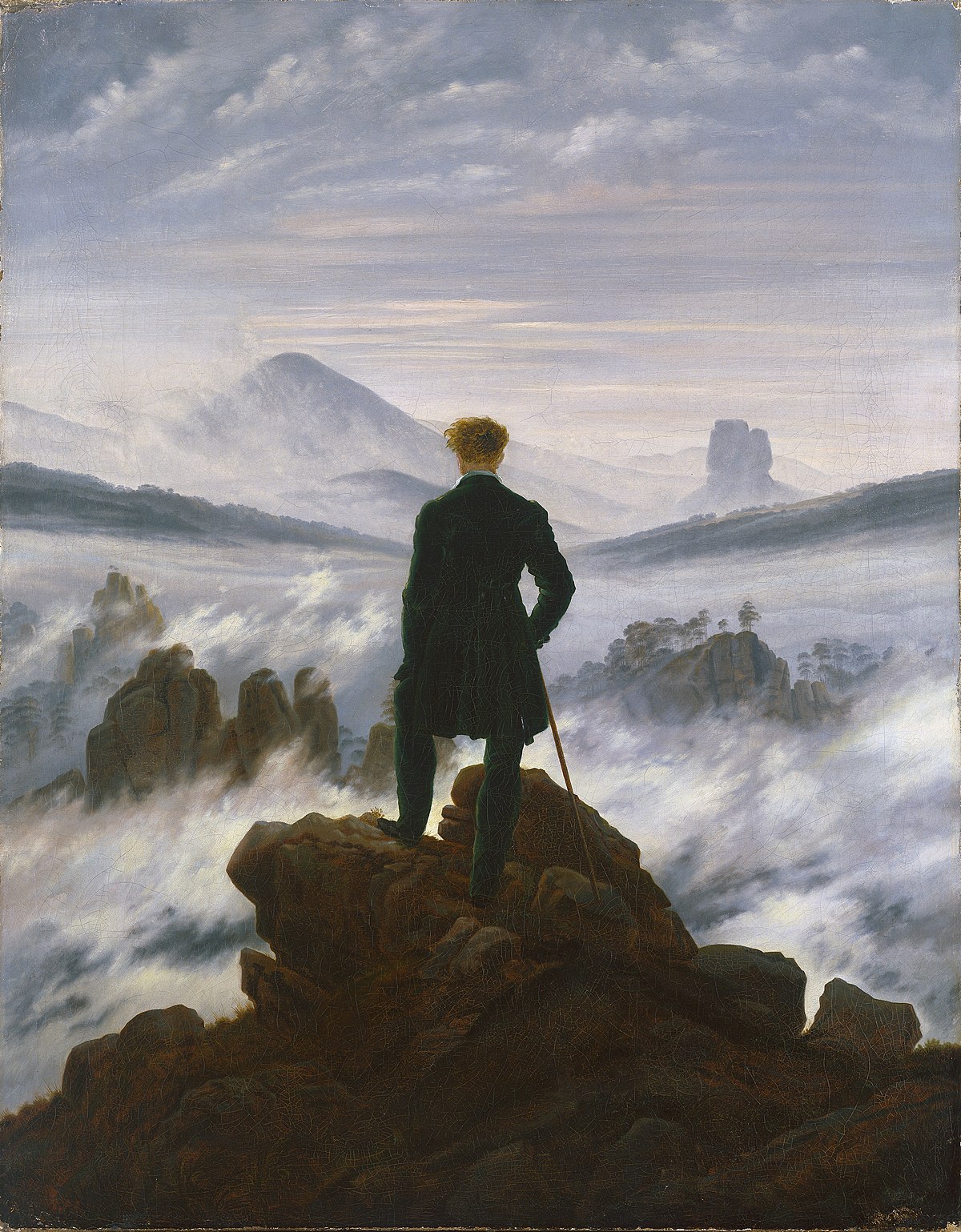
Casper David Friedrich "Wanderer above the Sea of Fog" (1818)
Casper David Friedrich, born in Greifswald, then part of Swedish Pomerania but now Germany, is a seminal figure in the Romantic movement, celebrated for his poignant landscapes that evoke a deep sense of melancholy, spirituality, and introspection. Friedrich's work is characterized by its use of rugged natural scenes, often incorporating elements such as desolate ruins, solitary figures, and the vastness of nature, to explore themes of mortality, transcendence, and the divine. A key aspect of Friedrich's life that influenced his work was his deep spirituality and the personal losses he experienced, including the early death of his mother and the tragic loss of his brother. These events deeply affected Friedrich and are reflected in the contemplative and often somber mood of his paintings. He sought to capture not just the physical landscape but also its emotional and spiritual resonance, making his work profoundly moving and symbolic. Among Friedrich's most famous works are "Wanderer above the Sea of Fog" (1818), an iconic image of Romanticism that depicts a lone figure standing atop a mountain, gazing out over a vast, fog-shrouded landscape, symbolizing the quest for understanding in a sublime and uncertain world. Another significant piece is "The Abbey in the Oakwood" (1810), which portrays a ruined abbey surrounded by barren trees against a dark sky, evoking themes of decay, mortality, and the passage of time. While the exact number of works Friedrich produced is not definitively known, his oeuvre includes over 500 known works, comprising paintings, drawings, and etchings.
Max Liebermann (1847-1935)

Max Liebermann "The Flax Barn At Laren" (1887)
Max Liebermann, a painter and printmaker, and one of the leading proponents of Impressionism in Germany. Born in Berlin to a prosperous Jewish family, Liebermann's early work was influenced by the Realist tradition, focusing on scenes of rural life and labor. However, after spending time in Paris and being exposed to the works of French Impressionists like Manet and Degas, his style evolved significantly. He began to incorporate the Impressionist emphasis on light and color into his own work, which led to the creation of vibrant scenes of German life, landscapes, and portraits. Liebermann's role in the German art world went beyond his contributions as an artist; he was a pivotal figure in promoting modern art movements in Germany. In 1898, he helped to found the Berlin Secession, a group that broke away from the traditional art establishment to create a forum for the exhibition of avant-garde works. As its president, Liebermann worked tirelessly to advance the acceptance of Impressionism and Post-Impressionism in Germany. Among Liebermann's most notable works are "The Bleaching Ground" (1882), which depicts women working in a field, a theme common in his earlier work, and "The Flax Barn at Laren" (1887), showcasing his transition to a more light-filled and colorful palette. His later works include a series of portraits and self-portraits that are remarkable for their psychological depth and subtlety of expression. Throughout his life, Liebermann faced anti-Semitism, which intensified during the rise of the Nazis. Despite these challenges, he remained in Germany until his death in 1935. Today, Liebermann is celebrated for his significant contributions to German Impressionism and for his role in modernizing the German art scene.
Käthe Kollwitz (1867-1945)
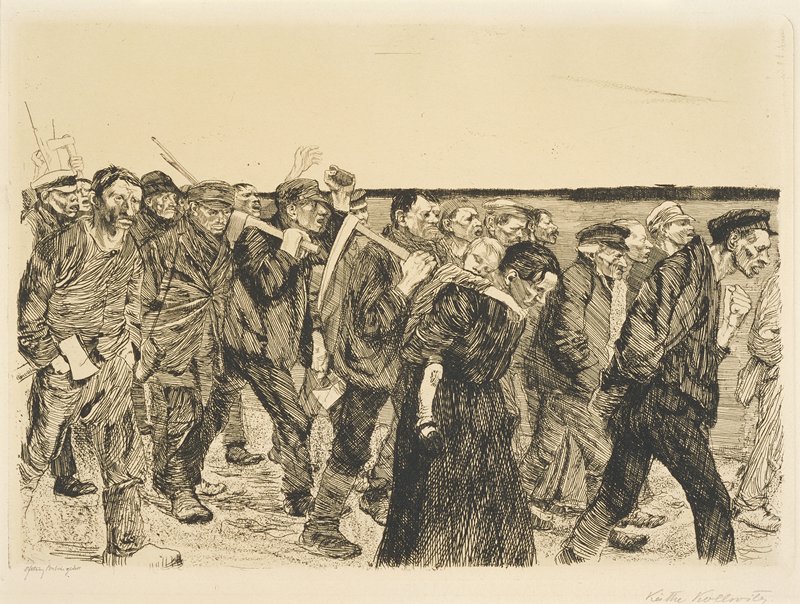
Käthe Kollwitz "The Weavers" 1893-1897
Käthe Kollwitz was known for her powerful depictions of social injustice, poverty, and the human cost of war. Born in Königsberg, East Prussia (now Kaliningrad, Russia), her work is characterized by its emotional intensity and its compassionate portrayal of the working class and the suffering caused by conflict. Kollwitz's art spans a variety of mediums, including etching, lithography, woodcut, and sculpture, making her a versatile and influential figure in the world of visual arts. Kollwitz's experiences living in Berlin, witnessing the hardships faced by the urban poor, and the personal tragedy of losing her youngest son, Peter, in World War I profoundly influenced her work. These events deepened her commitment to pacifism and her focus on themes of grief, motherhood, and loss. Two of her most notable works include "The Weavers" series (1893-1897), inspired by a weavers' uprising and showcasing her empathy for the plight of workers, and "The War" cycle (1922-1923), a series of woodcuts that reflect the devastation of World War I and her anti-war stance. Kollwitz was also remarkable for being the first woman elected to the Prussian Academy of Arts, although she was forced to resign by the Nazi regime. Despite the political and personal challenges she faced, Kollwitz's work remains a powerful testament to her artistic skill, her humanitarian spirit, and her unwavering dedication to social and political causes.
Emil Nolde (1867-1956)
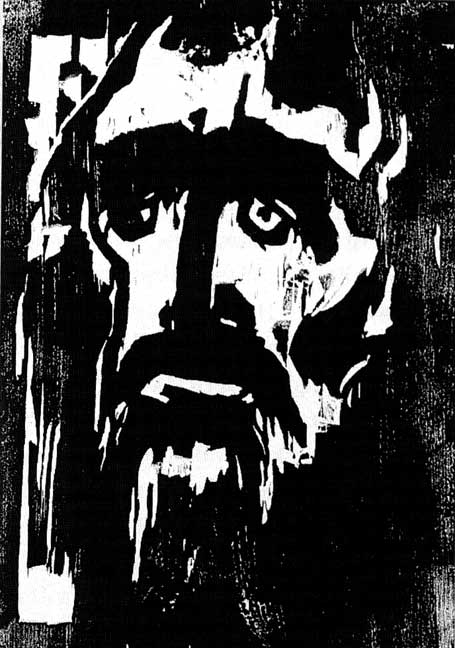
Emil Nolde "Prophet" (1912)
Emil Nolde was a German-Danish painter and printmaker, known for his vivid use of color and his association with the German Expressionist movement. Nolde's work is characterized by its intensity, with bold, emotive uses of color and dynamic compositions that explore themes of nature, religion, and mythology. Despite his association with Expressionism, Nolde's style was uniquely personal, often diverging from the theoretical underpinnings of the movement to follow his intuitive approach to art. One intriguing aspect of Nolde's life was his complex relationship with the Nazi regime. Initially a supporter, he faced a harsh reality when his work was condemned as "degenerate," and he was prohibited from painting. This period of enforced artistic silence, ironically, did not diminish his productivity; he continued to work in secret, producing a series of small watercolors known as the "Unpainted Pictures." Among his most famous works are "Prophet" (1912), a watercolor that exemplifies his use of stark contrasts and vivid colors to convey emotional and spiritual intensity, and "The Last Supper" (1909), which showcases his interest in religious themes through an Expressionist lens. His oeuvre includes several hundred paintings, watercolors, and prints, making him one of the most prolific artists of his time.
Paula Modersohn Becker (1876-1907)

Paula Modersohn Becker "Reclining Mother And Child" (1906)
Paula Modersohn-Becker was a groundbreaking painter, whose work prefigured the Expressionist movement. As one of the early pioneers of modernist art, she is celebrated for her bold use of color and form, as well as her innovative approach to depicting the female form and motherhood in art. Modersohn-Becker's career was marked by her exploration of self-portraiture, becoming one of the first women artists to paint nude self-portraits, challenging traditional norms and conventions of female representation in art. She spent significant periods of her life in the artist colony of Worpswede, where she was influenced by the landscape and rural life, but her most productive period was during her stays in Paris. There, she was exposed to the work of contemporary artists like Paul Cézanne and Henri Rousseau, whose influences can be seen in her approach to composition and form. Among her notable works are "Self-Portrait with Amber Necklace" (1906) and "Reclining Mother and Child" (1906), which showcase her unique style of capturing the essence of her subjects with bold outlines and vibrant colors. Despite her brief career, cut short by her death at the age of 31, Modersohn-Becker produced a remarkable body of work, including over 700 paintings and a thousand drawings and sketches. Paula Modersohn-Becker's contributions to modern art were not fully recognized until after her death, but today she is acknowledged as a significant figure in the transition towards modernism and Expressionism in art.
Paul Klee (1879-1940)

Paul Klee "Twittering Machine" (1922)
Paul Klee was a Swiss-German artist known for his unique contribution to modern art, blending elements of Expressionism, Cubism, and Surrealism. His work is celebrated for its imaginative approach to color and form, often infused with a whimsical or fantastical quality. Klee's interest in music, poetry, and dreams significantly influenced his artistic output, leading to creations that are lyrical and evocative, characterized by their delicate gradations of color and meticulously plotted compositions. His works often feature abstracted figures and symbols, set within colorful, dreamlike landscapes that seem to exist outside of conventional time and space. Among his most famous works are "Twittering Machine" (1922), an enchanting depiction of mechanical birds that blurs the lines between the natural and the artificial, and "Senecio" (1922), which showcases Klee's mastery of color and abstraction in portraying a human face. Throughout his career, Klee was a prolific artist, producing nearly 10,000 works, including paintings, drawings, and etchings. Klee's life was marked by his profound intellectual engagement with art theory, his active participation in avant-garde movements, and his resilience in the face of adversity, including Nazi persecution and health challenges.
Franz Marc (1880-1916)
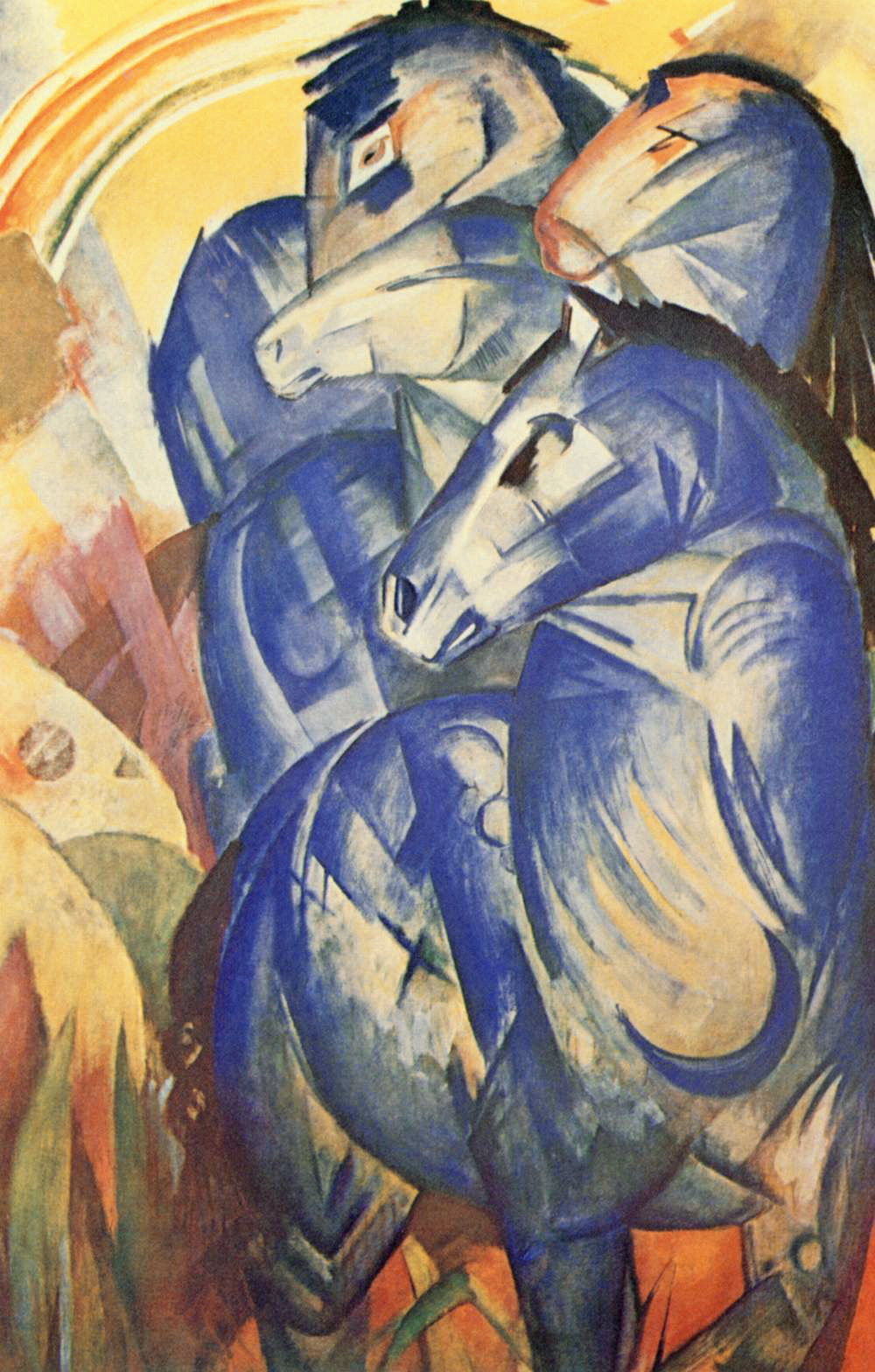
Franz Marc "The Tower Of Blue Horses" (1913)
Being a founding member of Der Blaue Reiter (The Blue Rider) organization, which aimed to convey spiritual truths via art, Franz Marc was a key figure in the German Expressionist movement. Marc is well-known for his vivid and intense paintings of animals, which he felt had an innocence and purity that was lost on people. Marc's artistic philosophy was deeply influenced by his interest in European medieval art, as well as the burgeoning theories of color symbolism and animal psychology. He sought to depict the essence and inner being of animals, using color in a symbolic manner to express emotion and spiritual concepts. Blue, for example, represented masculinity and spirituality, yellow depicted feminine joy, and red symbolized violence and chaos. Among his most famous works are "The Blue Horse I" (1911), which exemplifies his innovative use of color and form to capture the spiritual essence of the horse, and "The Tower of Blue Horses" (1913), long considered a masterpiece of Expressionism, though it was tragically lost during World War II. Tragically, Marc's career was cut short when he died in combat during World War I at the age of 36.
Otto Dix (1891-1969)
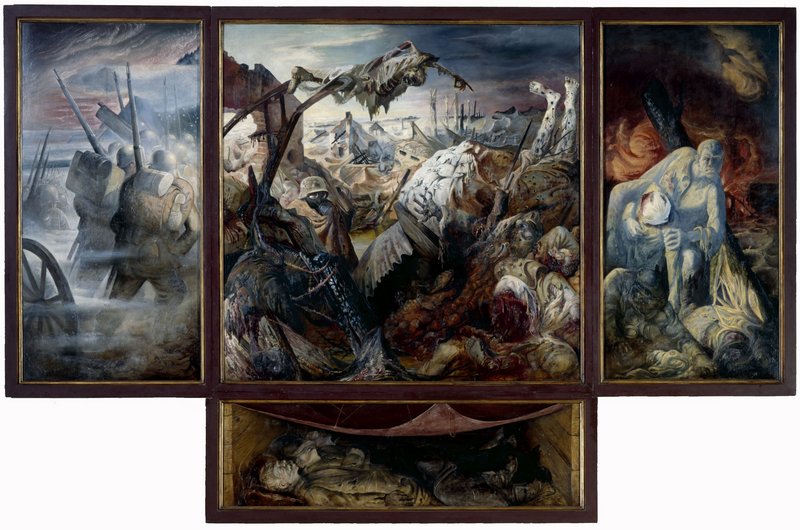
Otto Dix "The War" (Der Krieg)
Painter and printmaker Otto Dix gained fame for his brutal and uncompromising depictions of society and the horrors of war. A veteran of World War I, Dix's experiences on the front lines deeply influenced his artistic vision, leading him to depict the horrors of war and its aftermath with stark realism. His work spans the realms of Expressionism, Dadaism, and the New Objectivity movement, through which he critiqued the social, political, and moral decay of the Weimar Republic. Dix is best known for his keen observational skills and his ability to capture the grotesque and the visceral on canvas, often emphasizing the despair and destruction that followed World War I. His art serves as a historical document of the tumultuous period between the two World Wars in Germany, characterized by sharp social contrasts and political upheaval. Among his most notable works are "The War" (Der Krieg), a series of etchings that rivals Goya's "Disasters of War" in its depiction of wartime atrocities, and "Portrait of the Journalist Sylvia von Harden" (1926), which exemplifies his critical approach to portraiture, revealing the decadence and existential ennui of the Weimar era. Despite facing persecution during the Nazi regime, which deemed his work "degenerate," Dix's legacy as a critical observer of his times endures. His ability to convey the human condition through powerful, often disturbing imagery, makes him a pivotal figure in 20th-century art.
Max Ernst (1891-1976)
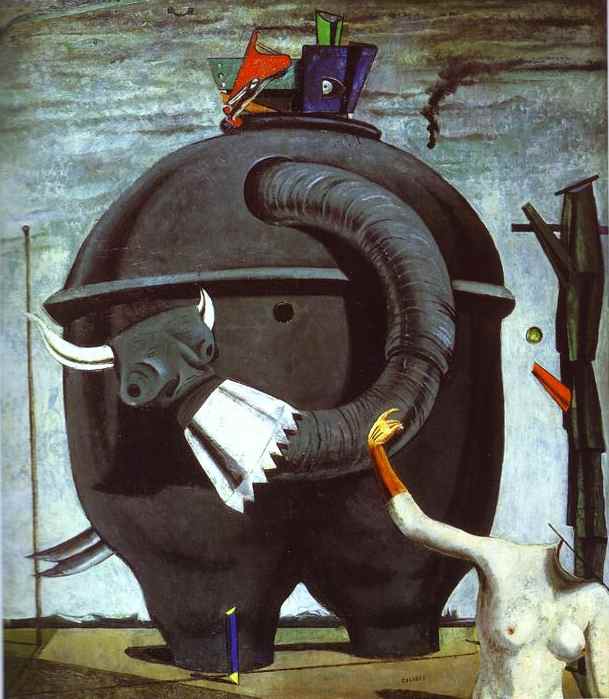
Max Ernst "The Elephant Celebes" (1921)
Painter, sculptor, poet, and graphic designer Max Ernst was a key figure in the growth of Surrealism and the Dada movement. Ernst's artistic journey was marked by constant innovation, including the invention of frottage (creating textures by rubbing over textured surfaces), grattage (scraping paint off the canvas to reveal lower layers), and decalcomania (pressing paint between surfaces to create textures). These techniques reflected his interest in chance and the unconscious, aligning with the Surrealist fascination with dreams and the irrational. "The Elephant Celebes" (1921), one of his best-known pieces, is a perfect example of how he challenges viewers' preconceptions and delves into the unconscious mind with surreal, dreamlike imagery. Another significant piece, "Two Children Are Threatened by a Nightingale" (1924), combines painting, sculpture, and architecture, blurring the boundaries between reality and fantasy in a way that became characteristic of Surrealist art. Throughout his life, Ernst faced significant challenges, including imprisonment during World War I due to his nationality, and later, like many of his contemporaries, fleeing Nazi Germany because his art was condemned as degenerate by the regime. Despite these hardships, or perhaps because of them, his work remains a testament to the resilience of the human spirit and the power of imagination.
Gerhard Richter (1932-)

Gerhard Richter "Betty" (1988)
Gerhard Richter is one of the most influential contemporary artists, known for his versatile exploration of both abstract and photorealistic painting styles. Richter's oeuvre is a testament to the medium's enduring relevance, seamlessly blending painting techniques to question the nature of representation, memory, and perception. Richter's artistic journey is marked by a continuous interrogation of imagery, from his photorealistic depictions based on photographs to his later abstract works characterized by squeegee techniques that layer and scrape paint across the canvas. His photorealistic painting of his daughter "Betty" (1988), which captures the fleeting moment of turning away, and his series "October 18, 1977" (which melancholicly depicts the Baader-Meinhof gang and the conflict between political action and state power in post-war Germany) are two of his most famous works. With a career spanning over six decades, Richter's contributions have been recognized globally, with his works commanding significant attention in the art market and exhibited in major museums worldwide.
Anselm Kiefer (1945-)
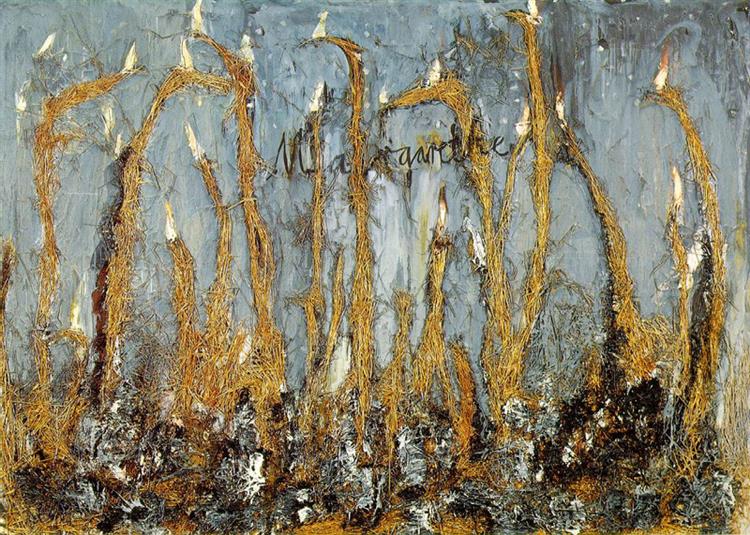
Anselm Kiefer "Margarethe" (1981)
Anselm Kiefer is a contemporary artist known for his expansive approach to addressing the themes of German history, mythology, and identity through a variety of mediums including painting, sculpture, and installation art. Kiefer's work is deeply influenced by the shadow of World War II and the Holocaust, exploring the moral and cultural implications of these events on the German psyche and broader human experience. Kiefer's art is characterized by its material intensity and textural depth, often incorporating elements such as straw, ash, clay, lead, and shellac. This use of materials is not just aesthetic but symbolic, imbuing his works with a weighty physicality that underscores the gravity of his themes. His landscapes and architectural structures, sometimes apocalyptic in tone, reflect a profound engagement with history and its ruins, both literal and metaphorical. Among his notable works are "Margarethe" (1981), inspired by Paul Celan's poem "Death Fugue," and "The Orders of the Night" (1996), which features a vast field under a dark sky, populated with sunflowers that allude to life, death, and rebirth cycles. These works exemplify Kiefer's ability to weave together personal and collective memory, myth, and history into compelling visual narratives. Kiefer has been recognized internationally for his contributions to art, with his works held in major collections and museums around the world.
We've simply mentioned a few of the most well-known and influential German artists who have affected the art world over the last few centuries. These figures have played crucial roles in founding and expanding several art trends, leaving an unmistakable impression not only in Germany, but around the world. From the emotive depths of Expressionism to the dreamy regions of Surrealism, German artists have made significant contributions to pushing boundaries of artistic expression and leaving a lasting international legacy!
No Comments Yet...